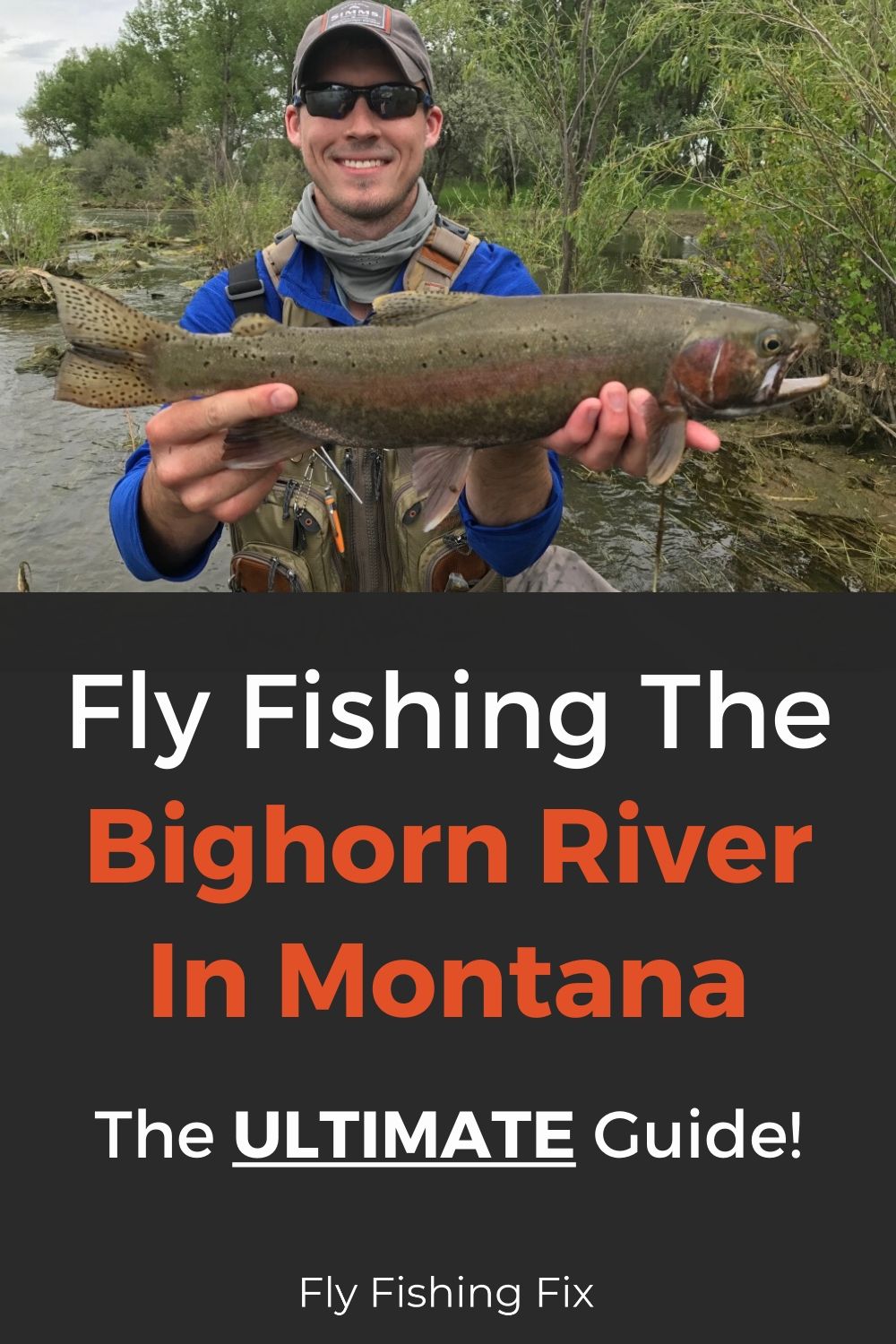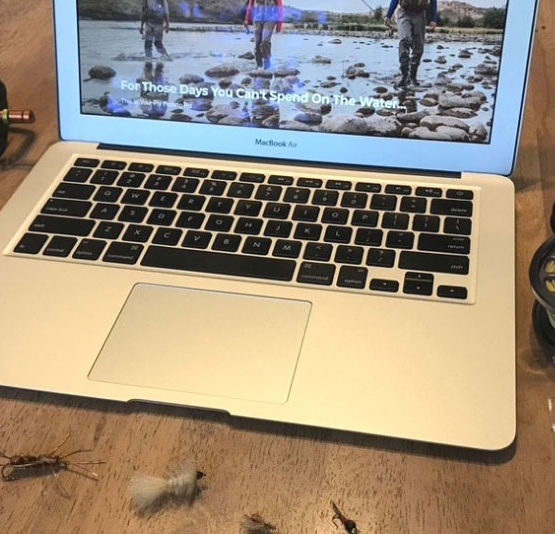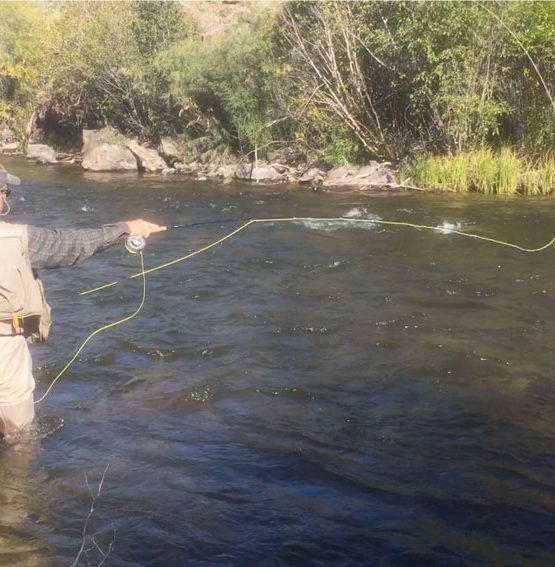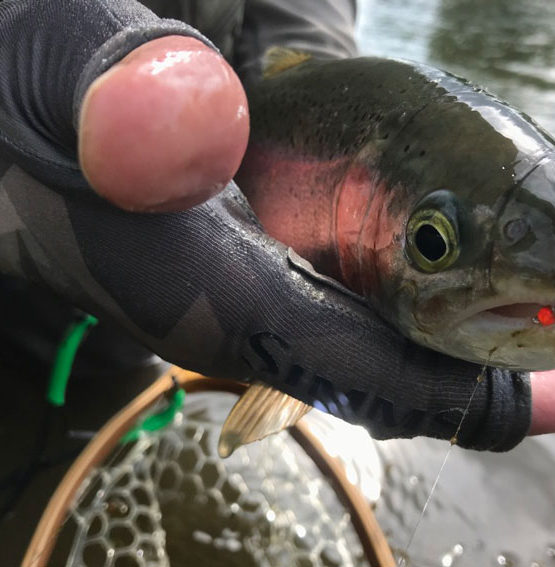Welcome to the ultimate guide to fly fishing the Bighorn River in Montana.
I’m writing this post so that if you’re new to Montana’s Bighorn River, you’ll benefit from a lot of our experience about what to do, and what not to do, to make your trip more enjoyable and to catch more of the Bighorn’s legendary, hard-fighting trout.
Disclaimer: This post may contain affiliate links, meaning we will receive a small commission (at no cost to you) if you click through and make a purchase.Part 1 – Planning And Preparation
When planning a fly fishing trip to the Bighorn River, it’s helpful to have the pre-trip steps mapped out for you, so, here is a checklist of pre-trip essentials. (And, for the sake of efficiency, I’ll assume you know who you’re going with, how you’re planning to get there {i.e. flights, ground transportation, directions}, how long you’re planning to stay, etc.
Similar Content:
- 9 Killer Nymphing Tips For Beginners
- Why Is Fly Fishing Addictive?
- Fly Fishing Gear For Beginners – Here’s What You Need
Book your lodging
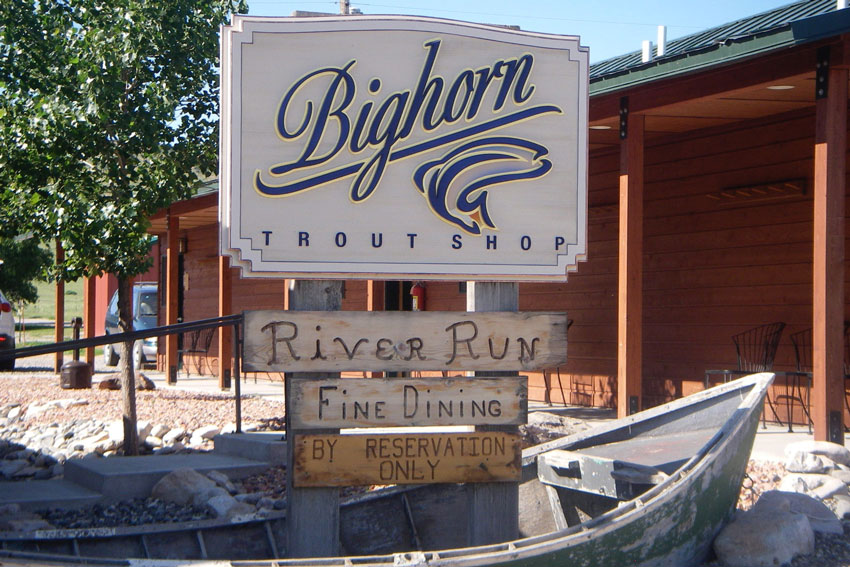
I feel like this goes without saying, but if you’re planning to go anywhere on vacation for a certain length of time, you’re going to want to book your lodging ahead of time. In other words, don’t assume it’ll be easy to find someplace to stay when you get there.
Ft. Smith, Montana is very much a fly fishing town. To me, among its most attractive attributes are that it’s rustic and that it doesn’t change much from year to year. Whereas, if you travel to a ritzy destination, you might see new hotels and attractions each time you go there, Ft. Smith isn’t that. The local lodging, though generally nice, is geared toward anglers and hunters. You won’t even find a Motel 6. And since it is a bucket list level attraction for many a fly fishing angler, you’ll want to nail down your dates early and, assuming you want to go during peak season, book as far out in advance as possible.
Ft. Smith’s fly fishing accommodations range from campgrounds and serviced RV slips to full-service, Orvis Endorsed sportsman lodges with top-of-the-line facilities, fly shops, guides, drift boats, and gourmet dining. Just as you would for any vacation, let your needs, wants and budget determine where you lay your head. Although we lean toward the lower-priced options, we still like to be able to walk to a fly shop, bring our own food, grill out, and have reliable indoor plumbing, including good showers with plenty of warm water. Since we bring our own food and beverage, we also need a decent refrigerator, stove, oven and dishwasher. Yes, these are things you need to take into consideration when booking your stay in Ft. Smith.
Related Content:
Get your Montana fishing license (online) ahead of time
There is nothing that’ll kill your Bighorn fly fishing buzz more than having to wait for you, and of all your buddies, to get your Montana fishing license issued when all you really want to do is get to the river. Trust me on this one; although the Ft. Smith area has better cell and wifi service than it used to, getting your license from the local lodges and/or fly shops is ALWAYS an agonizingly slow process, especially if you’ve never before been entered into Montana’s fish & game licensing system. Go here to get your license ahead of time.
It’s helpful to watch their instructional video too. If you plan to fish for several days, check the rates for the most economical license (i.e. 2-day, 10-day, season, etc.). If you plan to fish four days in-a-row, for example, two subsequent 2-day licenses may be the best way to go.
Check the weather forecast

In a single day, the Bighorn River Valley can bring a wide variety of weather extremes: from bone-chilling cold to sweltering heat; from heavy thunderstorms with wicked lightning to bright blue skies and sun; from periods of fierce wind to light breezy perfection.
You should know, the Bighorn River flows through the Crow Indian Reservation. You will be floating down a river with very few access points. It would be very easy to be complacent about the weather and, if poorly prepared, suddenly find yourself in a life-threatening situation. Know the daily forecast. Dress in layers. Be overly prepared with a well-stocked dry bag.
Here’s the best site for a reliable 7-day forecast. Bookmark this link and check it ahead of time and frequently during your trip.
Know the CFS (cubic feet / second a.k.a. river flow volume)
Given our group members’ busy schedules, we’ve usually fished the Bighorn in June, right before Father’s Day, but have been there as early as May. As a tailwater, the discharge out of Yellowtail Reservoir is regulated and, thus, the river’s CFS can change suddenly and frequently. Over the years, we’ve seen the river’s CFS running as low as an incredibly skinny and unhealthy 1,500 CFS, all the way up to a treacherous blowout of over 15,000 CFS, and at just about every level in-between.
As with any river, and for a variety of reasons, the expected CFS is an incredibly important statistic to know. It has everything to do with boat rentals, (most boat rental places won’t rent if the CFS is over 8,000), fly hatches, the presence of other types of biomass, what holes will be fishable, what side channels will or won’t be open, how fast you’ll be able to make your way down river, and more.
Here’s the best place to find out what the Bighorn River’s CFS is, what its previous pattern has been, and what it is expected to be over the days ahead. To get a good idea of what you can expect during your trip, pay close attention to the CFS graph on this linked page. The other good news is that every local lodge and fly shop will have the daily CFS posted. They’ll also have a general feel for the possible daily flow changes.
Related Posts:
Review the hatches
When booking your Bighorn lodging, pay close attention to the various lodge and outfitters’ websites. Nearly all of them feature local hatch charts and most keep their blogs fairly up-to-date with what’s been working. Researching ahead of time is a good idea, however, unless you’re a fly-tying aficionado, our primary recommendation is to buy your Bighorn flies locally, upon arrival and re-stock daily. To save a few bucks, there are certainly some Bighorn River staples you could pre-purchase online, but be prepared to spend a few bucks with the local fly shops. They have the best intel on the hot flies, the best variations, and the most productive sizes. Buying local also helps sustain the health of the Bighorn River Valley’s economy, so it’s a win-win.

Related Posts:
Book a guide
As Bighorn newbies, the best thing we ever did was to book our first few days on the river with local guides. Depending upon your level of desire to be hands-on types like us, once you’ve enjoyed a guided fly fishing day on the Bighorn River, you may never want to do it any other way. But going that route can get a bit pricey, so we bit the bullet a few times, booked guides, learned as much as we could about the river, the most productive holes and wading spots, the best techniques, how to be good on the oars, timing our way down river, and how much food, beverage and extra equipment to bring. We learned the rest from hundreds of days on the river since, but it was the excellent Bighorn River guides that laid the essential foundation.
Rent a Good Drift Boat
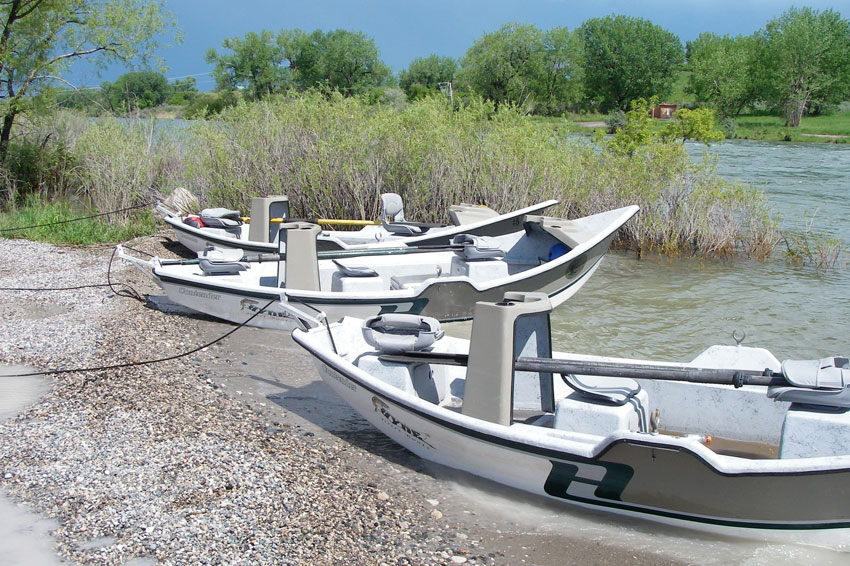
If you book a guide, you needn’t worry about renting a boat. He or she will have a boat and just about everything else you might need. That said, if you don’t already have your own drift boat or raft, boat rental is a great option. Since owning a drift boat has never quite busted into my financial top priority list, we’ve been content to rent. If you book well in advance, many of the lodges keep a bullpen of boats to rent. The best thing about renting is not having to wait in line at the boat ramp and then go through the rigamarole of offloading your boat from your trailer. When we rent, we tell the boat rental people where to put our boats in, at what time to do so, and at which ramp we’ll be ending our day. They take care of the rest. Beautiful! And, at the end of a long day, it’s nice not having to load a boat back up onto a trailer. Be sure to bring money to tip your boat people, and be generous; they work hard and stay late.
Bring your own food and beverage
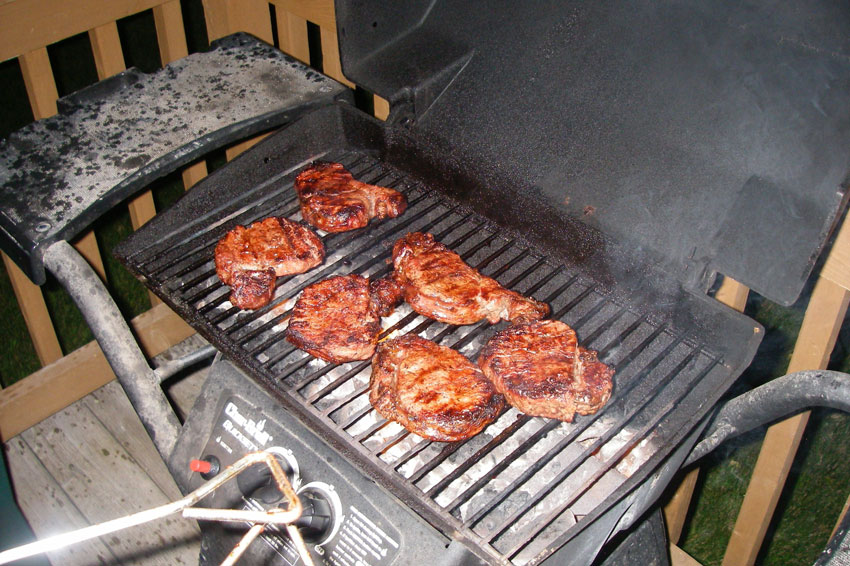
The evening before we hit the road from Denver to Ft. Smith, we engage in what has become sort of a ritual. We call it “The Shop.” As hands on fellows (remember?), we bring all of our food and beverage. Feeding and keeping several guys supplied with plenty of water, Gatorade and other frosty adult beverages is a considerable undertaking, requiring a great deal of meal planning. Other considerations include special dietary issues and making sure we cover all the easily forgotten basics, like butter, lemons & limes, individually packaged chips, condiments, coffee, extra TP, and so forth. Of course, if you’re planning to stay with some of the more expensive, full-service lodges, your F&B needs may not be as substantial, but it’s important to think it all through, including hauling all of it up there and keeping perishables and beverages cold.
Additionally, while there are a couple of small restaurants in the Ft. Smith area, don’t rely on them to be your mainstay, nor should you assume that you can hit a local grocery store or nearby Walmart if you run out of stuff. There is a small market in Ft. Smith that we’ve had to hit a couple of times for eggs, milk, water and other sundries, but it’s not well supplied, and the nearest Walmart I’m aware of is in Sheridan, Wyoming, over 90 miles away.
Lastly, the Crow Indian Reservation is a vast expanse within which alcohol sales are prohibited. If you wish to imbibe, you’ll need to bring your own. Here’s an extra tip: bring more food and beverage than you think you’ll need. You can always split up what’s left and bring it back with you, but I can tell you from painful experience, it is a bummer to realize that your food and beverage supply isn’t going to hold out. To put a fine point on it: rationing sucks!
Gas up before dropping into Ft. Smith
Driving into the Bighorn Valley from the south, we always top off the tanks in Sheridan. You can get gas in or near Ft. Smith but the stations are few, the gas is expensive and it’s often in short supply. Between driving to the river’s put-ins and back to your lodge or base camp from its takeouts, with several days of shuttling your vehicle in-between, you’ll use up quite a bit of petrol. Best to have as full a tank as possible upon arrival. That way, you’re more likely to have enough gas to make it out of the valley and to a reasonably-priced and well-supplied station on your way home.
Part 2 – On The Water
Use appropriate line and tippet
Earlier, I talked about our first few trips to the Bighorn and how we booked guides and tried to learn as much from them as possible. I guess we must have missed the lesson on line and tippet because, once on our own, we reverted to old habits and the assumption that line and tippet should be as delicate and invisible as Japanese silk. Using 5X-based rigs, we certainly attracted our fair share of strikes, but as soon as one of the strong and feisty Bighorn trout took us out, down, up, over, through, and around, it didn’t take them long to snap us off as if we were using crackly old rubber bands instead of fresh line and tippet. It actually took one of our better guides to set us straight, and, ever since, we don’t go lighter than 4X tippet and usually stick with 3X line to 3X tippet and maybe taper down to 4X if we have a multi-fly rig. We still get broken off sometimes, but if you want to land Bighorn trout, lean toward heavier test.
Related Posts:
Add more weight (adjust depth frequently)
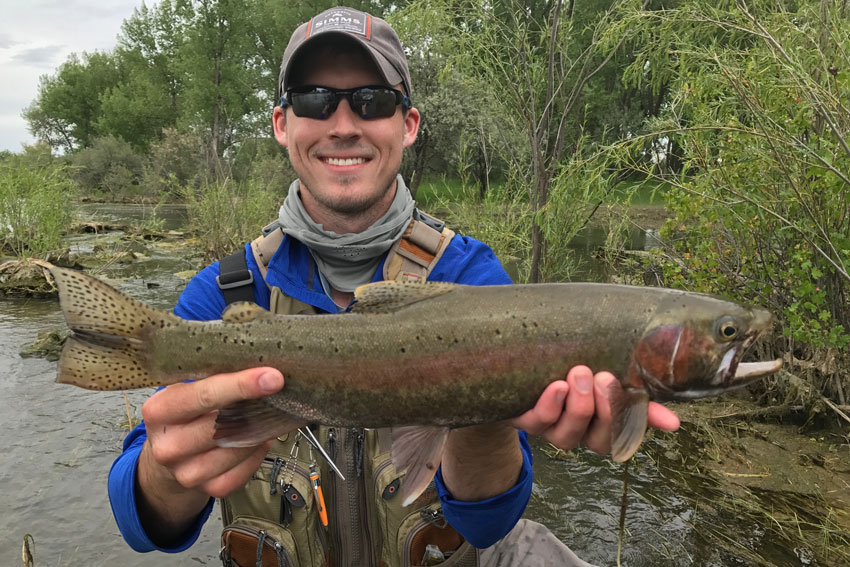
Among the various rivers I’ve fished, I wouldn’t call Bighorn trout the most finicky. Given a rig with commonly present flies, nymphs, annelids, crustaceans or streamers, these trout will readily hit. That said, they will refuse anything poorly drifted and, to my mind — and dry fly presentations notwithstanding — have always been particularly depth-selective.
Therefore, when presenting subsurface imitations, be willing to tinker with your depth adjustments. This should start with adding weight. More often than not, adding an extra split-shot or two will be the difference between a productive run and one that feels a little off. Of course, time of day, changes in CFS, water temperature, and the prevalence of hatches all play a role, but it’s amazing how crimping on one extra BB can change your fortune. Another depth micro-adjustment might involve moving your strike indicator up-line or down-line a few inches, especially if it’s a bulb-style, air-filled, indicator (which we absolutely recommend for nymphing the Bighorn).
Look for shelves, structure and set on the flash
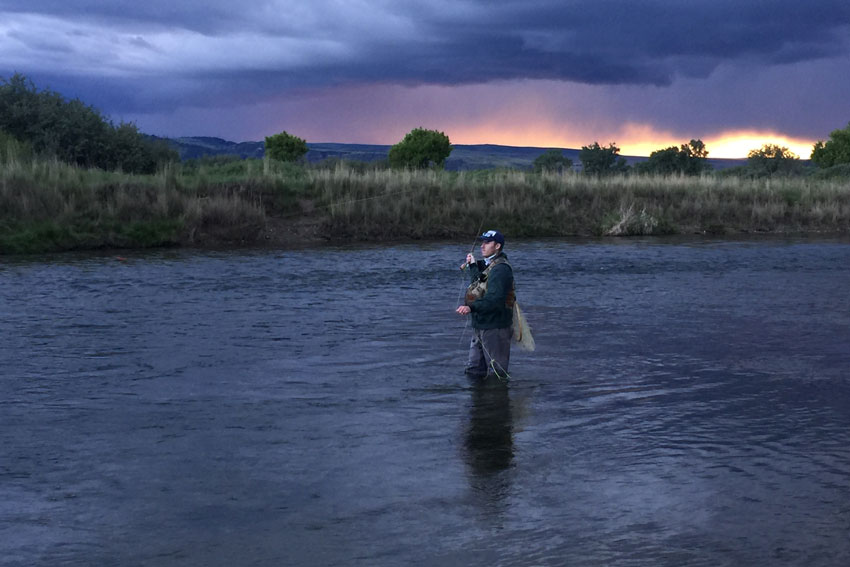
As they do on most rivers, Bighorn trout congregate where oxygen and food flow to them in abundance, and where they can hide from predators while reducing their current-fighting exertion. The Bighorn is famous for its pronounced underwater shelves and rock structures, which, assuming a low enough flow, are easily identified. Look for where the river shallows over a typically long and beautiful rock shelf, followed by a deep, dark run below it. By the way, these shelves are easily identified by rows of other anglers and their guides! (Click on this link for more details on how to read a river.)
And if you happen to arrive at one of them just as another group is leaving, don’t assume the fish have been left spooked. Just pull in, anchor up, check your rig, wade in to a good spot along the shelf, and off ya go.
A good tip is to cast into, and a couple of feet above the rock shelf and let your bugs sink while cascading into the depths below. The water flowing over the shelf will often curl under when it hits the deep water. If you find yourself in a run like this, rely more on seeing the flash of a striking trout more than your strike indicator, and set when you see the flash. In such a spot, indicator movement will often show too late, right as the aggressive trout has decided to spit out your offering. If you develop this skill, you’re likely to catch a lot more Bighorn trout and, believe me, it’s super fun and terribly exciting when you get hot working this kind of run.
Rig extra rods to be prepared to nymph, dry fly and strip streamers
One of the key things we learned from our guides is to always keep additional rods pre-rigged with nymph, dry fly and streamer setups. Be sure to check the licensing regulations when it comes to packing different rods. Your drift boat will typically feature extra rod tubes, which makes it easy to keep your extra pre-rigged rods safe when not in use, and makes for quick switch-a-roos when conditions and/or trout behaviors suggest a change.
Try double and triple rigs

At the risk of creating more potential gnarls, when nymphing, we recommend trying double and triple rigs. Extending your rig to more than one offering increases your odds of strikes and helps determine what flies the Bighorn trout are hungry for on a given day and time. A typical triple nymph rig might include a San Juan worm at the top (nearest to your line) with an orange or olive scud trailed a foot or two later, followed by a pink sow bug or small baetis pattern at the end.
With a rig like this, it’s important to minimize casting and, thus, hopeless rig gnarls (see roll cast section below). If you’re new to the game, stick with a single nymph rig until you’ve gained confidence. Add one bug at a time thereafter. Double and triple rigs complicate fly changes but can be well worth the extra effort.
By the way, double rigs work for streamers and dry flies too.
Use the tension roll cast
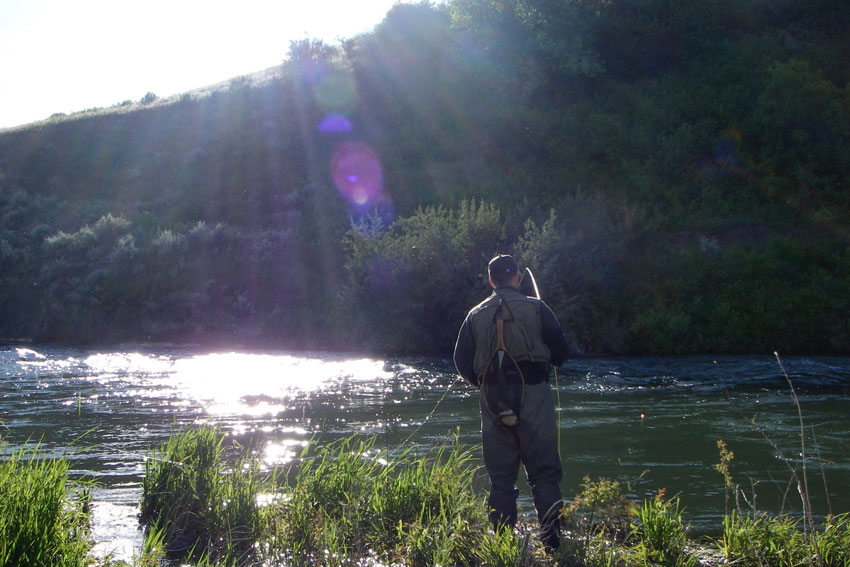
When fishing multiple imitation rigs on the mighty Bighorn, it’s helpful to minimize the potential for nasty gnarls by reducing cast frequency. Excessive back-casting, especially when snags and wind are working against you, is a rat’s nest waiting to happen. And there’s nothing quite as frustrating as either working your way out of a tangle or having to do a full re-rig while your buddies are hooping and hollering with fish-on all around you.
The answer: the tension roll cast.
Simply put, the tension roll cast makes use of the line tension created when your drift reaches its end point, down river. Using the tension formed by the current as your back-cast, simply raise your rod tip and perform a purposeful forward casting motion, which will end with your rod tip pointing, parallel to the river, at your forecast target. Your line and rig will come off the water, sail beautifully through the sky in a tight curl and land right where you aimed it. Easy peasy, lemon squeezy, and, better yet, your bugs will be drifting right through the money zone again, without tangles and wind knots.
If you haven’t mastered this simple casting technique, make a point of getting better at it, and you’ll be the one doing most of the hooping and hollering. One quick tip, if you have a lot of line out, you might want to strip it in a bit before making your tension roll cast. Too much line can result in a lagging cast that has the uncanny ability to make your flies (with sharp hooks) hit you right in the back of the head. This often leaves you with both a sore head and a self-snag. Yuck!
When nymphing, actively mend and lengthen your drift
Fly fishing anglers know that mending their line is standard fare for nearly all drift situations. When nymphing the Bighorn’s epic runs, it’s an essential and constant requirement. It’s also important that you do it well and pay attention throughout your drift.
Assuming casting directly up-river would be considered a 12 o’clock cast, you’ll typically roll cast to 2 o’clock and begin mending right away. As your line drifts past you, a great drift-lengthening technique is to, while mending, feed line out, directly above your flies in rod tip-flicked loops to lengthen your drift as it floats through the money zone. Feeding out a lot of line isn’t always the best nymphing practice, but, on the Bighorn, it works well. One of our early guides showed me this technique and I can’t tell you how often I’ve hooked up on hefty trout very late in a thusly lengthened drift.
This line feeding technique also gives a little jig to your nymph presentations that Bighorn trout often react to with a pronounce strike. At the end of your lengthened drift, there are additional techniques and benefits you’ll want to know, so, be sure to tune into the next section.
Swing, raise, flick and strip

Building on the drift-lengthening tip in the previous paragraph, there are three little things you must do to improve the frequency of hooking up on some of the hardest fighting trout on planet earth.
As your nymph rig reaches the end of its drift (lengthened or not), let it swing. In other words, don’t mend your line (or start a new cast) for the last few feet of your drift; let the current grab your line so that your underwater nymphs swing to a 6 or 7 o’clock position, directly down river. As they swing, slowly raise your rod tip and start stripping in your line in with short, semi-jerky strips.
This action perfectly mimics an emerging, aquatic-born insect, and Bighorn trout often react to this with a strong take. When this happens, you’ll usually know it. It’s a really fun and unmistakable feeling that instantly radiates from the very tail-end of your extended line right up to your grip. With a quick tip-flick set, you’ll be off to the races with a typically well-hooked trout.
This brings me to another one of my essential Bighorn nymph-drifting techniques: the side-flick-set. After you let your nymph rig swing out, and assuming you don’t feel the electric jolt of an aggressive strike “on the swing,” flick the tip of your rod, aggressively, cross-current (usually toward the bank) about two to three feet.
It’s amazing how often this last little action results in a hookup. Sometimes, if they don’t have to move very far to eat your imitation, trout will gently munch on a swinging nymph. This tip-flick maneuver will set your hook on a take you don’t necessarily feel… that is, until you realize it worked and, well… fish-on!
Incidentally, this is a good technique to try just about anywhere you might be drifting nymphs. Think of me fondly when it happens.
Learn the Bighorn Slap
One of the oft-lodged complaints about the Bighorn is the presence, at certain times of the year, of aquatic moss. I’ve heard it called by several names: cabbage, salad, green goop and some other not-ready-for-prime-time names. It tends to appear in Spring, gets worse through May and June, then clears out in mid-summer. When active, it becomes a bigger nuisance the further down river you float. At best, it can cause clarity issues. At worst (if flows are low during its active growing season) it can make it easier for hooked trout to get off, or even break your rod.
Recalling one particularly memorable episode, a lovely rainbow I had hooked took my rig through a clump of moss that, in turn, gathered on my line so heavy that, with rainbow and giant glob of moss in tow, my rod snapped right in half. Needless to say, and probably more frustrating than my splintered rod (I had a backup) I lost the dang fish!
These are the extremes. Most often, the problem is primarily isolated to gumming up your rig and bugs, and a trout simply will not hit a mossy fly. So what to do? Pick the junk off your rig and flies before every cast? Crazy as that sounds, that’s exactly what we used to do until a guide taught us “The Bighorn Slap.”
This maneuver will save you time and frustration and, if done frequently — when the moss is thick, before every cast — you’ll present clean flies that trout will certainly strike. Here are the steps:
- Before each cast (or as frequently as you feel you should), bring in your line to a manageable length.
- Target an area of the river around you that is not going to disturb the run you’re fishing. I will typically look toward the shallow water near the bank behind me, and either perform the slap with a forehand or backhand orientation, as my river position demands.
- Perform a fairly aggressive cast but, as your rig nears the water, keep your cast going in a circular motion so that your entire rig, weights to last bug, slaps the water as it gets pulled back toward you. You can accentuate this rig-cleansing motion by pulling back on your line’s loop, just ahead of your reel, as your rig jerks through the water.
- Continue your back cast as you normally would, with your next cast going back into the money zone, featuring a nice clean rig.
This motion vanquishes your flies, line and weight of the green menace in, usually, one swoop, however, you might have to slap your rig more than once to make sure it’s completely clean.
Comb the banks with streamers

As you may have gleaned from this post, and given the time of year we most frequent the Bighorn, we spend about 80% of our time on the water nymphing. The remaining 20% is spent eating, lounging, waiting to get in a desirable spot and combing the banks with streamers. Dry fly opportunities come up from time to time, but fishing dries gets way better a little further into the summer. Streamers, on the other hand, are a fun alternative throughout the year, and can result in some of the most ferocious takes you’ll ever experience.
The best technique is to comb the banks with your streamer-rigged rod as you float from hole to hole. Usually with a shorter, heftier line weight, cast either a single or double streamer rig from boat-to-bank, almost as if you were trying to snag your streamer in the reeds. Then, immediately strip it (or them) off the bank in alternatively and varied short and long strokes, through the current until your rig is back to the side of your boat.
Ideally, you’ll want to cast quartered, down-river (i.e. with boat pointed down, 10 or 11 or 1 or 2 o’clock) so your stripping will move your streamers up-current. The first strike on a streamer is often an angry bump, so try not to set a streamer hit with a traditional set. Since it’s such a sudden and exciting feeling, it’s hard to resist a traditional setting motion but, if you can keep from wetting yourself, upon initial strike, strip to set instead. If the first strike is a bump, the strip-set will keep your streamer in the water for the second “money” strike that is sure to come. That said, more often than not, the initial strike has been a winner for me too.
To summarize: if the Bighorn trout have decided to be active on streamers, you may have the most epic day of exciting fly fishing you’ve ever experienced.
Take note of where the guides place their clients
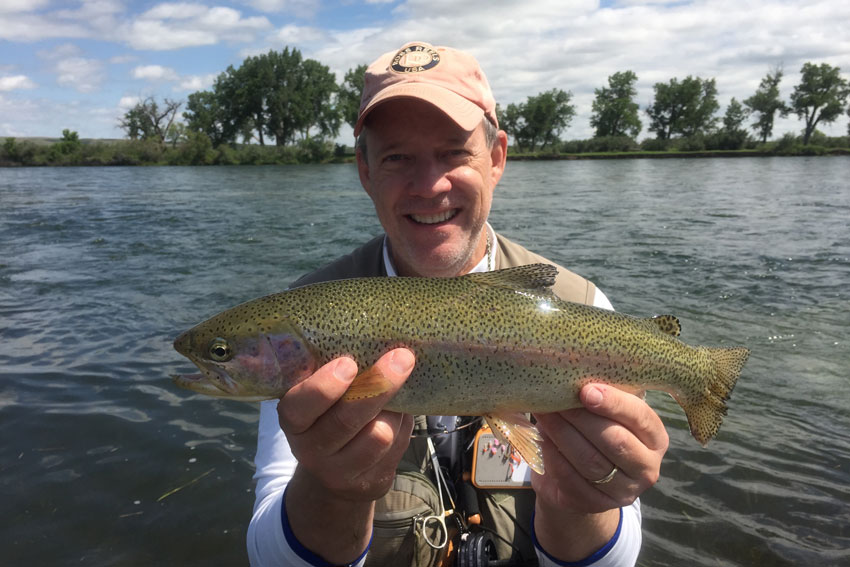
If nothing else, good fly fishing anglers tend to be highly observant. One of the best ways to apply this skill is to take careful note of the spots on the river where guides camp out with their clients. Over our many years of fly fishing the Bighorn, this simple act has opened up numerous hotspots we might have otherwise never known about. Now, if the river gets a little busy, we can easily visit any number of productive, off-the-beaten-path holes in our Bighorn River memory catalogue. Build your library similarly, and you’ll drastically reduce the chances of having an “off day” on the Bighorn.
Final Thoughts
As much as I’ve attempted to cover the most important considerations and success-ensuring techniques of a fly fishing trip to the legendary Bighorn River, this post undoubtedly leaves many things un- or under-addressed. For instance, I decided to leave out that Montana is home to some of the world’s most relentless and insatiable mosquitos, so, while you pretend I didn’t even write that last sentence, don’t forget to bring some high-powered repellent.
In the meantime, we would love for you to add your Bighorn trip additions, experiences, stories and essentials. So, please do so in the comment field below. And may the Bighorn River odds be ever in your favor!
Tight lines!
